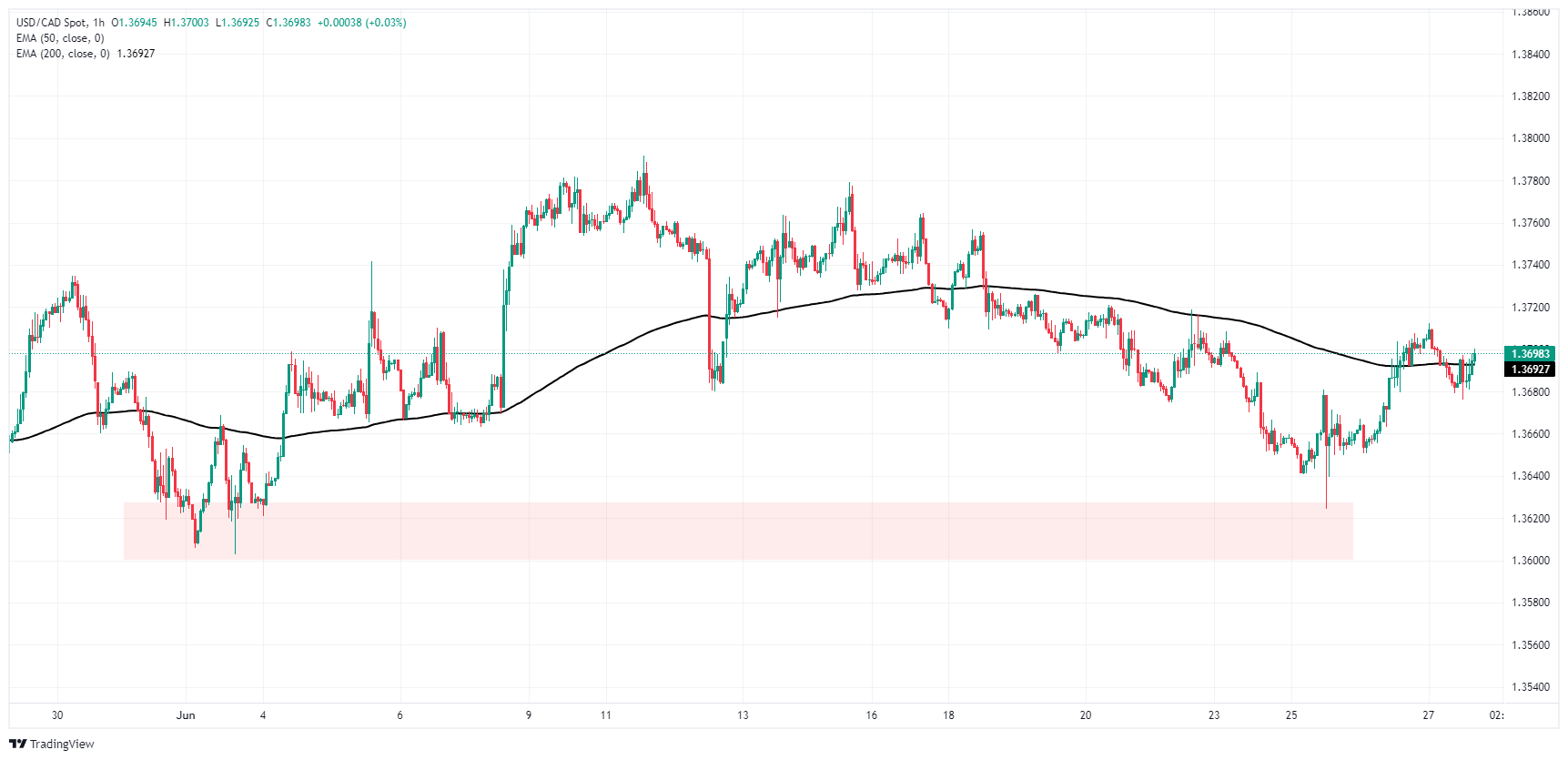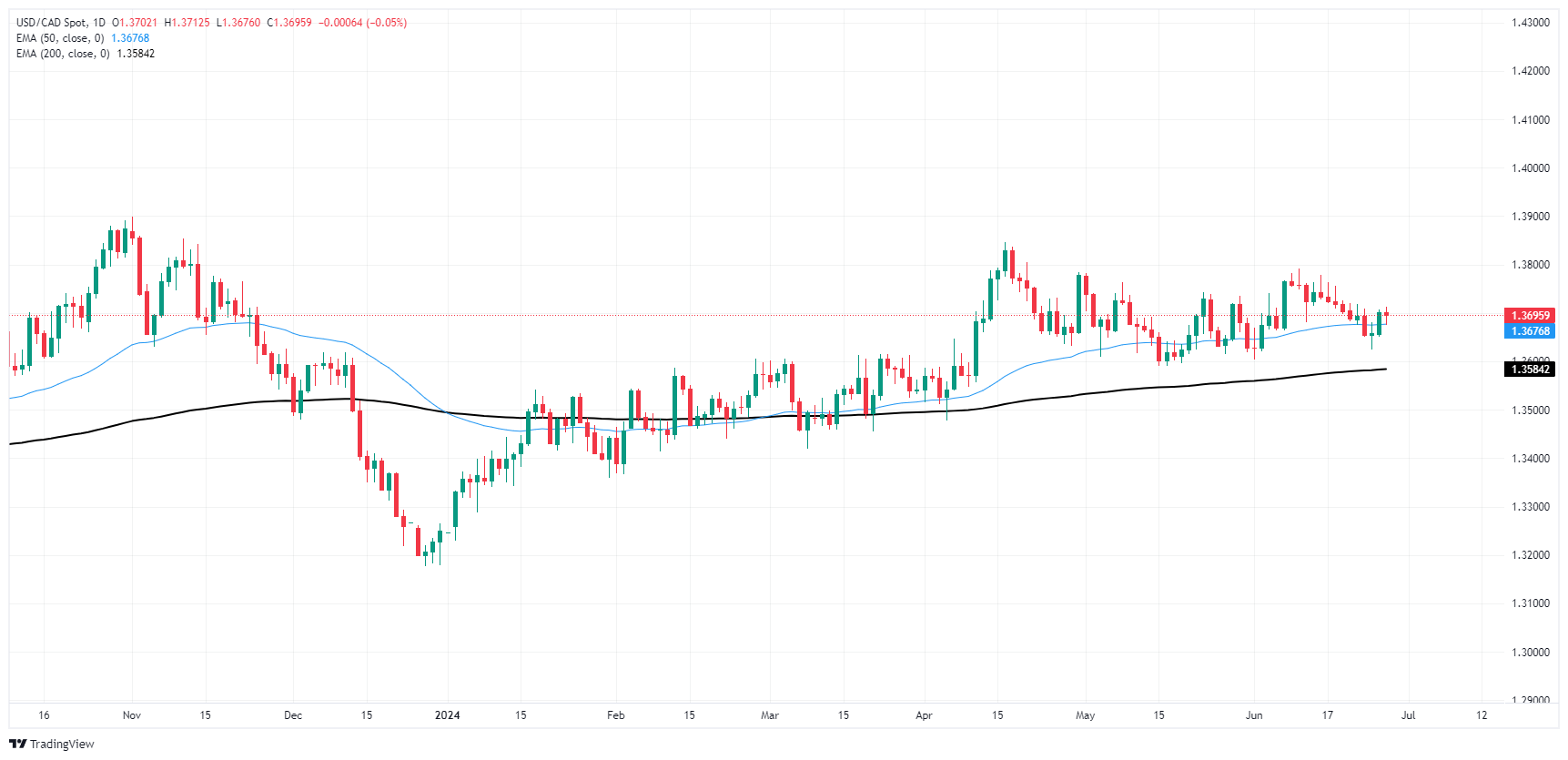- Analytics
- News and Tools
- Market News
- Canadian Dollar mixed on Thursday as CAD traders await Canadian GDP
Canadian Dollar mixed on Thursday as CAD traders await Canadian GDP
- Canadian Dollar went in both directions on Thursday’s mixed US data.
- Canada is absent from economic calendar until Friday’s GDP update.
- US PCE Price Index inflation also looms ahead on Friday.
The Canadian Dollar (CAD) gave a mixed performance on Thursday after a data-light economic calendar on the Canadian side left the CAD to twist amid a mixed print in key US figures. Markets are gearing up for Friday’s US Personal Consumption Expenditure Price Index (PCE) inflation release after Thursday’s burgeoning US release schedule ran the gamut.
Canada is absent from the economic calendar on Thursday, leaving CAD traders to shuffle in place until Friday’s Canadian Gross Domestic Product (GDP) update for April.
However, Friday’s US PCE Price Index inflation is set to eclipse Canadian GDP figures entirely. As a key reading of inflation for the Federal Reserve (Fed), significant market attention will be focused squarely on US price growth figures to cap off the trading week.
Daily digest market movers: US data comes in mixed, Canadian Dollar follows suit
- US Durable Goods Orders contracted in May, clocking in -0.1% MoM versus the forecast 0.2%, falling further than expected from the previous 0.4%.
- US Q1 GDP came in exactly as expected with first-quarter GDP slightly revised to 1.4% from the initial print of 1.3%.
- US Initial Jobless Claims beat expectations with 233K net new jobless benefits seekers for the week ended June 21. Median market forecasts had expected a print of 236K compared to the previous week’s 238K.
- US Core Personal Consumption Expenditures, a preview of Friday’s PCE Price Index, ticked upwards to 3.7% in the first quarter versus the expected hold at 3.6%.
- Friday’s Canadian MoM GDP in May is expected to rebound to 0.3% from the previous flat print.
- US core PCE Price Index inflation is expected to ease to 0.1% in May from the previous 0.2%.
Canadian Dollar PRICE Today
The table below shows the percentage change of Canadian Dollar (CAD) against listed major currencies today. Canadian Dollar was the strongest against the Swiss Franc.
| USD | EUR | GBP | JPY | CAD | AUD | NZD | CHF | |
|---|---|---|---|---|---|---|---|---|
| USD | -0.24% | -0.22% | -0.06% | -0.11% | -0.02% | -0.12% | 0.07% | |
| EUR | 0.24% | 0.00% | 0.15% | 0.11% | 0.23% | 0.09% | 0.31% | |
| GBP | 0.22% | -0.00% | 0.18% | 0.11% | 0.23% | 0.12% | 0.32% | |
| JPY | 0.06% | -0.15% | -0.18% | -0.05% | 0.04% | -0.09% | 0.15% | |
| CAD | 0.11% | -0.11% | -0.11% | 0.05% | 0.08% | -0.01% | 0.19% | |
| AUD | 0.02% | -0.23% | -0.23% | -0.04% | -0.08% | -0.10% | 0.08% | |
| NZD | 0.12% | -0.09% | -0.12% | 0.09% | 0.01% | 0.10% | 0.20% | |
| CHF | -0.07% | -0.31% | -0.32% | -0.15% | -0.19% | -0.08% | -0.20% |
The heat map shows percentage changes of major currencies against each other. The base currency is picked from the left column, while the quote currency is picked from the top row. For example, if you pick the Canadian Dollar from the left column and move along the horizontal line to the US Dollar, the percentage change displayed in the box will represent CAD (base)/USD (quote).
Technical analysis: Canadian Dollar churns on data-light Thursday, but gains remain thin
The Canadian Dollar (CAD) is mixed on Thursday, giving a middling performance in overall quiet markets. The CAD is up over a tenth of a percent against the Swiss Franc (CHF) and the Japanese Yen (JPY), but falling back a fifth of a percent against the Euro (EUR) and the Pound Sterling (GBP).
USD/CAD is stuck close to Thursday’s opening bids after an early dip to 1.3680. The pair remains stuck in a price action trap near the 1.3700 handle as intraday bids get hung up on the 200-hour Exponential Moving Average (EMA) at 1.3692.
Daily candlesticks are forming a bullish bounce after running aground of the 50-day EMA at 1.3676 and is set to snap a near-term losing streak after the pair flubbed a bullish recovery of the 1.3800 handle earlier in June.
USD/CAD hourly chart
USD/CAD daily chart
Canadian Dollar FAQs
The key factors driving the Canadian Dollar (CAD) are the level of interest rates set by the Bank of Canada (BoC), the price of Oil, Canada’s largest export, the health of its economy, inflation and the Trade Balance, which is the difference between the value of Canada’s exports versus its imports. Other factors include market sentiment – whether investors are taking on more risky assets (risk-on) or seeking safe-havens (risk-off) – with risk-on being CAD-positive. As its largest trading partner, the health of the US economy is also a key factor influencing the Canadian Dollar.
The Bank of Canada (BoC) has a significant influence on the Canadian Dollar by setting the level of interest rates that banks can lend to one another. This influences the level of interest rates for everyone. The main goal of the BoC is to maintain inflation at 1-3% by adjusting interest rates up or down. Relatively higher interest rates tend to be positive for the CAD. The Bank of Canada can also use quantitative easing and tightening to influence credit conditions, with the former CAD-negative and the latter CAD-positive.
The price of Oil is a key factor impacting the value of the Canadian Dollar. Petroleum is Canada’s biggest export, so Oil price tends to have an immediate impact on the CAD value. Generally, if Oil price rises CAD also goes up, as aggregate demand for the currency increases. The opposite is the case if the price of Oil falls. Higher Oil prices also tend to result in a greater likelihood of a positive Trade Balance, which is also supportive of the CAD.
While inflation had always traditionally been thought of as a negative factor for a currency since it lowers the value of money, the opposite has actually been the case in modern times with the relaxation of cross-border capital controls. Higher inflation tends to lead central banks to put up interest rates which attracts more capital inflows from global investors seeking a lucrative place to keep their money. This increases demand for the local currency, which in Canada’s case is the Canadian Dollar.
Macroeconomic data releases gauge the health of the economy and can have an impact on the Canadian Dollar. Indicators such as GDP, Manufacturing and Services PMIs, employment, and consumer sentiment surveys can all influence the direction of the CAD. A strong economy is good for the Canadian Dollar. Not only does it attract more foreign investment but it may encourage the Bank of Canada to put up interest rates, leading to a stronger currency. If economic data is weak, however, the CAD is likely to fall.
© 2000-2024. All rights reserved.
This site is managed by Teletrade D.J. LLC 2351 LLC 2022 (Euro House, Richmond Hill Road, Kingstown, VC0100, St. Vincent and the Grenadines).
The information on this website is for informational purposes only and does not constitute any investment advice.
The company does not serve or provide services to customers who are residents of the US, Canada, Iran, The Democratic People's Republic of Korea, Yemen and FATF blacklisted countries.
Making transactions on financial markets with marginal financial instruments opens up wide possibilities and allows investors who are willing to take risks to earn high profits, carrying a potentially high risk of losses at the same time. Therefore you should responsibly approach the issue of choosing the appropriate investment strategy, taking the available resources into account, before starting trading.
Use of the information: full or partial use of materials from this website must always be referenced to TeleTrade as the source of information. Use of the materials on the Internet must be accompanied by a hyperlink to teletrade.org. Automatic import of materials and information from this website is prohibited.
Please contact our PR department if you have any questions or need assistance at pr@teletrade.global.















